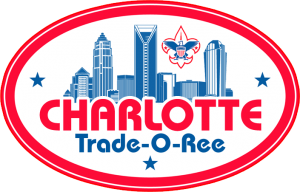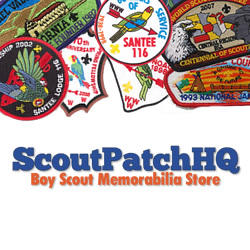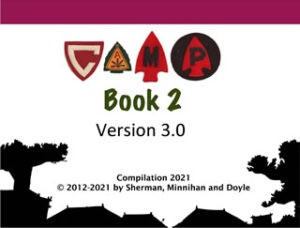SHF Radio: Order of the Arrow Blue Book 2.0 With Roy More
The effort to catalog and describe all known Order of the Arrow issues has been ongoing since the 1950s. Many old collectors will remember the Bill Price books that had a picture of each flap and attempted to describe the restrictions. David Leubitz had a book – the original Blue Book that tried to catalog the issues and introduced the vocabulary that many collectors are familiar with today such as “S” for solid embroidered flap and “F” for not fully embroidered flap. Later Albertus Hoogeveen and Richard Breithaupt revolutionized this effort with Arapahoe that was published in 1976 with pictures. Their innovation was to assign issue numbers to patches. The Arapahoe II Supplement was published in 1988 and reorganized the original catalog based on new information. However, Al Hoogeveen was drinking from a fire hose trying to keep up with new issues and it was just impossible to do.
During the process of updating the Arapaho the authors would reorder issue numbers to fix mistakes but this created a lot of confusion among collectors and dealers who had to figure out which reference guide had been used to ID a patch. Was the S5 from the first book the same as the S5 from the next update? Perhaps it was this renumbering of issues that led some collectors to begin work on a new Blue Book effort that would have a structure of national (4), regional (18) and lodge (100+) editors to make the final determinations on cataloging Order of the Arrow memorabilia.
In this session that was recorded at the Dallas TOR in 2013 there is a discussion led by Roy More of TSPA that catches up on that history and explains what is going on with Blue Book 2.0. The Blue Book was published in 1996 and eventually the printed book included 5 editions that came in two year intervals. The final version was released almost completely as a digital product in 2006.
Johnny Sneed of Louisiana is also in on the session and he served as one of the original regional editors and volunteered his time and talents to lay out the massive book. As he mentions on the tape his job was to “make it look better than Arapahoe”.
One of the defining rules of this Blue Book effort was to lock in issue numbers. So once a designation was made in the 1996 issue it was never changed throughout the life of the project. The first edition in had somewhere around 13,000 issues from all known lodges. Later editions added chapter issues and activity issues which inflated the catalog to where eventually the printed version of the 4th edition came as a 2 book set. By the time the 6th and final edition (2006) came out there were over 50,000 issues documented.
There are many challenges going into the Blue Book 2.0 effort. Regional editors have simply not been able to keep up with the flood of new issues. The effort to never renumber issues led to using decimals to sneak previous unknown issues into their sequential sequence which became a mess. Likewise issues that were later confirmed to never exist had been left in the book with that notation. Another hope is that a 2.0 of the Blue Book would allow for further notations that include things such as when and how many of different issues were made. Modern patch designs also feature two-piece flap sets and the numbering system considers these two different patches (typically and “S” and “X” issue) where the numbering of each shows no relation to them being issued together.
In speaking of the new Blue Book 2.0 which is owned by TSPA Roy uses the catch phrase “user supported but expert editor approved.” One of the big components of this project is a renumbering of the Blue Book catalog to correct mistakes and clean up the lodge listings. Along those lines one of the inconsistencies that plague the first effort was no common policy on varieties. Some people had a vested interest in listing more varieties because it gave them a chance to sell more patches. Roy would like to see a defined set of rules in this 2.0 version to bring a common standard to the rule book. Another innovation would be some sort of 3-stage process to decide disagreements between collectors over cataloging issues. The new project can also include more items that were left out of the original Blue Book.
Visit the Blue Book 2.0 Project Online
The discussion in this session then gets very detailed about how to change the way of cataloging issues covering many topics with the people in the room.








 Camp Director, Eagle Scout, Order of the Arrow Vigil Honor Member and past Chief, lifelong Scouter and patch collector.
Camp Director, Eagle Scout, Order of the Arrow Vigil Honor Member and past Chief, lifelong Scouter and patch collector.
Comments
Close